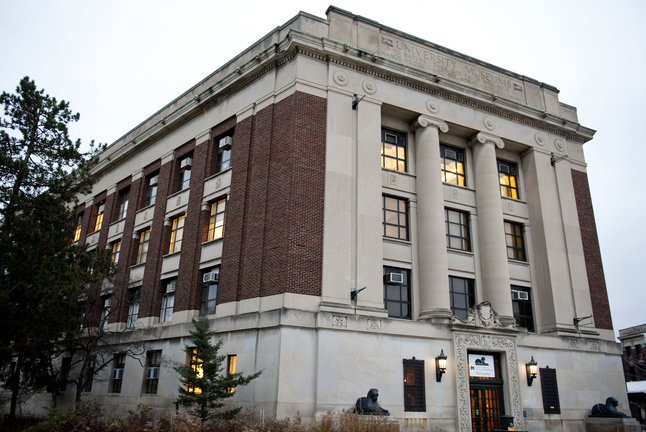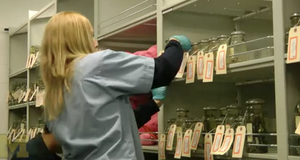University of Michigan to transfer thousands of artifacts out of Museum of Natural History building

The Ruthven Exhibit Building, which houses the Museum of Natural History, opened in 1928, according to University of Michigan records.
Daniel Brenner | AnnArbor.com
The transfer of artifacts, most of which are now kept in the the Museum of Natural History building, and the renovation of 71,000-square-feet of the Varsity Drive building is anticipated to cost $27.5 million.

Alcohol-perserved artifacts are moved into a building on Varsity Drive in Ann Arbor.
Courtesy of U-M
Administrators will seek permission for the transfer and renovation from the Board of Regents during a 3 p.m. Thursday meeting at the Michigan Union. Regents are anticipated to approve the project.
It's the second large-scale transfer of artifacts out of the Ruthven Exhibit Building, more commonly known as the building that houses the Museum of Natural History, in recent history.
In 2010, U-M approved the $17.6 million transfer of its zoology museum's alcohol-preserved collections to Varsity Drive and renovated nearly 7,000-square-feet of storage space within Ruthven. An estimated 5 million specimens were moved.
Along with the collections, the university also is transferring some zoology, paleontology and anthropology offices to the Varsity Drive building. According to an internal memo, 40 parkings spaces on central campus will free up because of the transfer.
"The storage space is pretty awful, the basement you can barely stand up straight in. It's really not the kind of storage space that's appropriate or best for the long-term," said U-M spokesperson Rick Fitzgerald said of the existing storage space within the Ruthven building. "What they're creating out on Varsity Drive is real good, in some cases climate controlled, storage space, versus the basement of an aging building."
Fitzgerald said the transfer is "not necessarily" related to a potential renovation or expansion of the Ruthven building, which U-M officials said they were seriously considering in December.
"We are studying it," Timothy Slottow, U-M's chief financial officer, said in a December interview. "It's very old and we are looking at meeting the needs of [the College of Literature, Science and Arts] biology faculty."
View Artifacts' pilgrimage in a larger map
Kellie Woodhouse covers higher education for AnnArbor.com. Reach her at kelliewoodhouse@annarbor.com or 734-623-4602 and follow her on twitter.


Comments
Epengar
Wed, Feb 20, 2013 : 3:36 a.m.
The quote from Rick Fitzgerald gives a false impression. This is not just moving "stuff in basement storage." This is four floors of active research collections. Hundreds of thousands of fossils, human artifacts, animal skeletons and study skins. The insect collection alone is over 4 million specimens. They moved the material preserved in alcohol first (mostly fish, amphibians, and reptiles), now they're moving the dry collections.
Veracity
Thu, Feb 21, 2013 : 3:41 p.m.
Mark - Perhaps you and your colleagues can petition the AATA to adjust its bus routes to better accommodate transportation to the Varsity Drive location.
Mark
Wed, Feb 20, 2013 : 6:11 p.m.
As a long-term employee within the building, the Fitzgerald statement really annoyed me. For one, the basement has been cleared out of most of its collections, as the specimens in alcohol were transferred to varsity Drive by August. The only other collections in the basement belong to the Museum of paleontology, which of course, will move to Varsity Drive. The people in the administration really have little knowledge about what goes on in collections and just think of it as "storage." Plus, it's not just "artifacts." Artifacts do not mean the same as biological collections. I have no idea where the 40 parking spaces figure comes from, as there certainly are not 40 spaces behind Ruthven Museums. For some of us, it will be a major pain, since we had excellent bus transportation to main campus, but the route on Ellsworth is not a good one.
keri
Tue, Feb 19, 2013 : 4:50 p.m.
I'm a bit confused how moving artifacts out of the building opens up 40 parking spaces. Could you clarify?
Epengar
Wed, Feb 20, 2013 : 3:40 a.m.
Along with the collections go the research and collection management staff who are being transferred to the Varsity Drive space. The curators who are in charge have joint appointments as professors, so will still be on Central Campus, but there are research scientists, post-docs, collection managers and other support staff who will get moved out permanently.
Kellie Woodhouse
Tue, Feb 19, 2013 : 5:08 p.m.
I requested more detail from the university yesterday, but still haven't received it. My understanding is that the parking spaces will be freed up from staff/offices moving to Varsity Drive...
Jake
Tue, Feb 19, 2013 : 4:16 p.m.
According to the map above, they are going to the parking lot of the old Borders headquarters.
Kellie Woodhouse
Tue, Feb 19, 2013 : 5:07 p.m.
Haha. It's an approximate location.
Epengar
Tue, Feb 19, 2013 : 3:21 p.m.
I work in the building. The official name for the building is the Ruthven Museums Building, because it houses (will have housed) both the public Museum of Natural History, and 3 research museums: Zoology, Paleontology, and Anthropology. Ruthven was was long-time president of the university, and also Director of the Museum when it was a single unit. It's the research collections that are being moved out to Varsity Drive. The U admins don't want collection storage on central campus, they want the space for classrooms, offices, and labs. The public exhibit museum, now officially the UM Museum of Natural History, will have its exhibits temporarily closed, but it's not shutting down permanently, and the staff are working on lots of traveling exhibits and other outreach while they're out of the building. The last I heard there was some question about whether the exhibits would stay in the Ruthven Building or move into new construction, but there have been endless rumors about this for years, and I'm low-level research staff and don't get reliable information.
hmsp
Tue, Feb 19, 2013 : 2:04 p.m.
I used to rummage around in that basement. Very cool place, felt like the basement of a museum. The new place will be just another fluorescent-lit lab.
Veracity
Thu, Feb 21, 2013 : 3:36 p.m.
A museum is defined by its contents and not by its shell.
HB11
Tue, Feb 19, 2013 : 12:39 p.m.
I sure hope that $27.5 million includes the cost of the new building.
Elaine F. Owsley
Tue, Feb 19, 2013 : 1:05 p.m.
There is no mention of a "new" building.
mgoscottie
Tue, Feb 19, 2013 : 12:14 p.m.
Are they removing storage items or dinosaur displays?
pegret
Tue, Feb 19, 2013 : 5:04 p.m.
Just items currently in storage.
Mark
Tue, Feb 19, 2013 : 12:13 p.m.
Thousands is a major understatement. Millions of biological specimens will be moved.
thinker
Tue, Feb 19, 2013 : 12:03 p.m.
It's a shame that all the things interesting to children-the American Indian villages, the bones, etc.- will be gone from the Museum.
thinker
Wed, Feb 20, 2013 : 3:13 a.m.
Still not visible for school-age children to see.
Elaine F. Owsley
Tue, Feb 19, 2013 : 1:05 p.m.
I believe the story makes it clear that these are "stored" items kept in the basement of the museum, not displayed in the museum galleries.
J. A. Pieper
Tue, Feb 19, 2013 : 11:27 a.m.
This Google map is wrong - switch the blue marker for Varsity Drive with the spot they have Bryant Pattengill School.